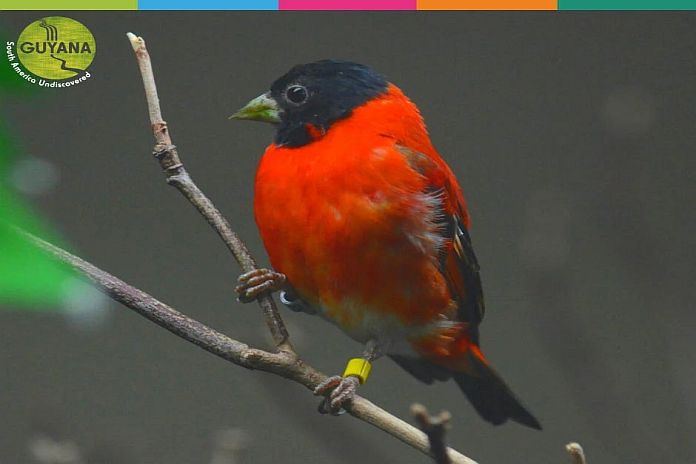By Indranie Deolall
About two decades ago, the unexpected, recorded find of a lifetime along the rolling plains flanked by the Kanuku Mountains, thrilled conservationists and became world-famous in ornithological lore.
Led by experienced indigenous guides, an American scientific team jointly organised by the Washington-based Smithsonian Institution stumbled across an isolated, vivid Guyanese treasure. They found an undocumented population of the rare wild finch holdout with its brilliant crimson colour and blackhead, called the Red Siskin, surviving in the remote, ancient south-western corner of our country, dominated by bunch grasses, and the bird’s preferred home of the “caimbé” or rough-leaved “sandpaper tree,” Curatella americana, with its sweet, pale edible flowers and tillandsia draped branches.

Rich wildlife diversity
The word “Kanuku” means “forest” in the Wapishana language, a reference to the zone’s incredibly rich diversity of local wildlife, including over half of our known bird species and nearly three-quarters of our mammals, ranging from the Giant otter, and the Harpy eagle to the Arapaima.
While observing a mixed-species flock at the edge of the Rupununi forest, and savannah dotted with “bush islands,” on April 12, 2000, the veteran Evolutionary Biologist, Mark Robbins – who has a special ear, many thousands of recordings and the perfect gear for different avian songs – heard a small flock of Carduelis-like birds fly overhead. The genus Carduelis is a group in the finch family Fringillidae.
Since no Carduelis was known from the area at that time, the intrigued collections manager at the University of Kansas Biodiversity Institute, quickly followed and located the group a few minutes later. He was stunned to see three adult male and two adult female Red Siskins nonchalantly perched in the top of a leafless tree about 15 metres above the ground. During the next hour, he located an additional three pairs and at least one more female in a tiny area of about a quarter to one kilometre.
Must be dreaming
Relating the moment of discovery, an amazed Robbins said, “Quite unexpectedly, I heard siskins calling as they flew overhead and out of sight” and “When I realized what they were, I thought I must be dreaming.”
That expedition was co-led by Michael Braun, a Research Scientist in the Department of Vertebrate Zoology at the Smithsonian’s National Museum of Natural History. “It was like seeing a ghost,” admitted Braun. “Ornithologists had pretty much given up on this bird in the wild, outside of a small, local population in far western Venezuela near the border with Colombia.”
Subsequently removed from the Carduelis genus, the updated Red Siskin is now termed Spinus cucullatus, with the International Union for Conservation of Nature (IUCN) continuing to feature the beautiful bird as “endangered” on the alarming Red List of species, whose populations are declining globally. The List is the world’s most comprehensive inventory of the conservation status of biological species.

Feared extinction
Until that extraordinary Guyana find of an estimated several hundred Red Siskins at least, worried ornithologists feared the wild bird could go extinct, given that it was extensively snatched from its native northern sliver of South America, for the insatiable caged-bird trade especially in Europe, over a deadly and devastating century and a quarter.
With the Siskins’ breeding population severely fragmented in much of its historic range, the Smithsonian team surveyed an expanded area, returning in October through early November that year. Focusing on the Guyanese Siskins’ preferred habitat of savannahs and semi-humid woodlands, they managed to identify nearly 130 of the birds, calculating a possible total of a minimum of 675 specimens along adjoining terrain such as the Kanuku’s slopes and hills.
The researchers surmised that the population was densest at the initial site because of optimal habitat, with the broad area of sandpaper trees-dominated scrub interspersed with seasonally flooded marsh that helped reduce burning at the base of the mountain. So, the edge areas of relatively low-stature second-growth between the semi-humid forest and savannahs remained extensive. In stark contrast, only a few kilometres away, hills were devoid of any woody vegetation because of excessive fires, the scientists noted in a 2003 paper for “The Auk,” a peer-reviewed quarterly scientific journal and the official publication of the American Ornithological Society.
A close secret for years
They theorised that the Guyana Siskins, were separated by about 950 km, with intervening rain forest and tepui mountains, from all known Venezuelan populations, extirpated or extant. “If we assume a vicariant origin, geographic barriers and the geological and vegetational history of northern South America would seem to indicate that this new population may have been isolated from the known Venezuelan populations for at least 8000–10,000 years.”
Reporting on efforts to help bring back the iconic bird from the brink, the Smithsonian’s Institute for Biodiversity Genomics, explained, “Even in their excitement, the researchers realized how extremely valuable these birds would be on the international black market for the pet trade, so they kept the information about their find a close secret while they sought official protection for the red siskin in Guyana. After it was added to the country’s endangered species list and legal protections against trafficking were in place, the scientists were able to publish their findings without specific location information to announce the discovery of Guyana’s population of red siskins to the ornithological community.”
Obsession with Red Canary
The Institute recalled that the feathers and even whole birds adorned elaborate women’s hats and other clothing items in the early 1900s. As a popular caged-bird in many countries, thousands were captured for the pet trade, and even now trapping continues illegally. But the main reason for its disastrous decline was the early 20th-century lethal obsession to produce a red canary, causing the Red Siskin to be driven almost to extinction to meet the incessant demand of aviculturists who were hybridizing it with domestic canaries.
It seems hard to believe, but the Red Siskin once graced the region’s skies in huge flocks across northern Venezuela into Colombia and even the island of Trinidad. But the bird has vanished in most places, and the few lonely groups in volatile Venezuela may number only a few hundred individuals, experts warn, with sightings in the wild, increasingly scarce.
Disappeared from Trinidad
The IUCN pointed out, the Red Siskin has long disappeared from Trinidad, “where it was never anything other than rare,” but there existed a handful of records up until 1960s, although the natural origin of those birds is open to question due to the extensive finch trade. Efforts to revive and breed the wild Red Siskin in Trinidad had to be abandoned due to diseases. A small population persists in Colombia, while another set in Puerto Rico, derived from escaped cage-birds, is sliding. The world’s total population is rounded to merely 1,500-7,000 mature individuals, the IUCN said.
Days ago, there was some welcome news. Several of the indigenous Guyanese who had guided the Smithsonian/University of Kansas expedition came together as concerned friends, shortly after the 2000 discovery, to help reverse the fate of the endangered bird, forming the well-known South Rupununi Conservation Society (SRCS), currently headed by president, Leroy Ignacio. On March 5, the Society announced on its’ Facebook page, that it has been awarded more critical financing, this time from the prestigious United States’ National Geographic Society to continue its invaluable work saving the Red Siskin.
SRCS protection zone
“The funding will be used to implement a Community Based Conservation Management zone to protect the Red Siskin from threats including trapping and habitat destruction. The project will involve collaborating with local villages to design the zone and will also use locally trained rangers to then monitor it. A massive thank you to National Geographic Society.”
*ID longs to see a wild Guyanese Red Siskin in the Rupununi, but she has to be content with the Saffron Finches, numerous Tanagers, Grayish Saltators, garrulous Parrots and even the pair of Scarlet Macaws that come by her home.





